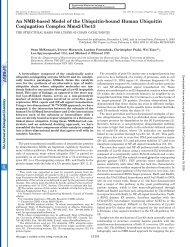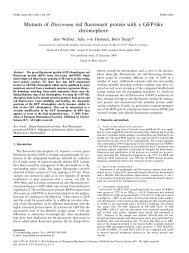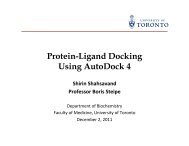Tumor Initiating Cells, Cell Cycle Control and Cancer Stem Cells
Tumor Initiating Cells, Cell Cycle Control and Cancer Stem Cells
Tumor Initiating Cells, Cell Cycle Control and Cancer Stem Cells
You also want an ePaper? Increase the reach of your titles
YUMPU automatically turns print PDFs into web optimized ePapers that Google loves.
<strong>Tumor</strong> <strong>Initiating</strong> <strong><strong>Cell</strong>s</strong>, <strong>Cell</strong> <strong>Cycle</strong> <strong>Control</strong> <strong>and</strong> <strong>Cancer</strong> <strong>Stem</strong><br />
<strong><strong>Cell</strong>s</strong><br />
Eldad Zacksenaus<br />
MGY-425<br />
MSB 3171<br />
March 5, 2012
<strong>Cancer</strong> is a highly heterogeneous disease<br />
1. Distinct oncogenic networks<br />
2. Distinct tumor subtypes due to different cell of origin<br />
(<strong>and</strong> transforming oncogenic networks)<br />
3. Hierarchical organization with <strong>Cancer</strong> <strong>Stem</strong> cells (CSC)/<br />
<strong>Tumor</strong> initiating cells (TICs) capable of self-renewal <strong>and</strong><br />
tumorigenicity at its apex, <strong>and</strong> non-TICs which were derived from<br />
TICs but have lost their tumorigenic potential forming tumor bulk<br />
4. Clonal evolution.
Hallmarks of <strong>Cancer</strong>: The Next Generation<br />
Douglas Hanahan <strong>and</strong> Robert A. Weinberg<br />
<strong>Cell</strong><br />
Volume 144, Issue 5, Pages 646-674 (March 2011)
Stochastic versus hierarchical models of cancer<br />
Primary tumors<br />
Transplantation<br />
Secondary tumors<br />
Stochastic: all cells<br />
have the capacity<br />
to induce tumors but<br />
the process is not efficient<br />
(e.g. most cell die after<br />
transplantation)<br />
Hierarchical: only a small fraction<br />
of tumor cells – cancer stem cells/<br />
tumor initiating cells – is capable<br />
of inducing tumors.
Isolation of tumorigenic cells.<br />
Al-Hajj M et al. PNAS 2003;100:3983-3988<br />
©2003 by National Academy of Sciences
Histology from the CD24+ injection site (a; ×20 objective magnification) revealed only normal<br />
mouse tissue, whereas the CD24−/low injection site (b; ×40 objective magnification)<br />
contained malignant cells.<br />
Al-Hajj M et al. PNAS 2003;100:3983-3988<br />
©2003 by National Academy of Sciences
Phenotypic diversity in tumors arising from CD44+CD24−/lowLineage− cells.<br />
Al-Hajj M et al. PNAS 2003;100:3983-3988<br />
©2003 by National Academy of Sciences
Breast cancer stem cells revealed<br />
John E. Dick<br />
PNAS April 1, 2003 vol. 100 no. 7 3547–3549
A model depicting the hierarchical organization of the breast cancer tumor. A rare <strong>and</strong> primitive<br />
breast cancer-initiating cell (BrCa-IC) maintains the breast cancer tumor. BrCa-IC possess high self-renewal<br />
capacity; however, they can also mature or differentiate into breast cancer cells that have lost the ability<br />
to sustain the tumor. Some of these cells may still possess extensive proliferative capacity indicative of a<br />
progenitor cell, but have lost the ability to sustain the tumor after transplantation. The breast cancer cells<br />
that comprise the bulk of the tumor tissue retain remnants of normal differentiation genetic programs.
Can non-TICs spontaneously reverse into TICs<br />
Primary tumors<br />
Transplantation<br />
Secondary tumors<br />
Normal <strong>and</strong> neoplastic nonstem cells can spontaneously convert to a stem-like state.<br />
Chaffer CL, Brueckmann I, Scheel C, Kaestli AJ, Wiggins PA, Rodrigues LO, Brooks M,<br />
Reinhardt F, Su Y, Polyak K, Arendt LM, Kuperwasser C, Bierie B, Weinberg RA.<br />
Proc Natl Acad Sci U S A. 2011 May 10;108(19):7950-5.
Implications of CSC model to chemotherapy<br />
<br />
Reya T et al . Nature<br />
2001:414
Model of the human mammary epithelial hierarchy linked to cancer subtype<br />
Prat & Perou, Nature Medicine 2009
Proto-oncogenes promote hallmarks of cancer<br />
<strong>and</strong> are activated in human cancer<br />
<strong>Tumor</strong> suppressors (TS) inhibit hallmarks of cancer<br />
<strong>and</strong> are lost in human cancer
For example, evasion of apoptosis:<br />
• Bcl-2 is a survival factor (It inhibits mitochondrial outer<br />
membrane permeabilization (MOMP) <strong>and</strong> the release of<br />
cytochrome c, which is required for caspase activation <strong>and</strong> cell death).<br />
- Bcl-2 is amplified in cancer - oncogene<br />
• p53 is an anti-survival factor (among other functions, it transcriptionally<br />
activates Bax which induces MOMP <strong>and</strong> cell death)<br />
-p53 is lost/mutated in cancer hence a TS (however most mutations in p53<br />
are not null but dominant negative that also inhibit p63 - hence oncogenic)<br />
• The TS RB inhibits cell proliferation - but also apoptosis. Its loss leads<br />
to ectopic proliferation (oncogenic) but also so apoptosis (tumor<br />
suppression).
Hallmark<br />
<strong>Tumor</strong><br />
suppressor<br />
Function<br />
Evading apoptosis p53 Induces apoptotic genes (Bax)<br />
Self-sufficiency in Pten Dephosphorylates PIP3, counteracting PI3K<br />
growth signal pRb Inhibits E2F - cell proliferation<br />
Insensitivity to anti- SMAD4 Induces CDK4/6 inhibitor p16 ink4a in response to TGF<br />
growth signals p16 ink4a Inhibits cyclins<br />
DNA damage stress ATM Induces p53 <strong>and</strong> DNA repair machinery<br />
Mitotic stress LATS2 Inhibits MDM2 (activates p53)<br />
Normoxia VHL E3 ligase of HIF-1 (induces angiogenesis)
signal<br />
+<br />
Signaling, oncogenes, tumor-suppressors<br />
<strong>and</strong> non-oncogene addiction<br />
Oncogene<br />
-<br />
<strong>Tumor</strong> suppressor<br />
-<br />
Negative regulator that is not mutated/lost in cancer<br />
+<br />
Positive regulator that is not activated in cancer<br />
but its inactivation blocks signaling - non-oncogene<br />
addiction
For example: The phosphatidylinositol 3-kinase (PI3K) signaling cascade<br />
Receptor tyrosine<br />
kinase<br />
G protein<br />
couple receptor<br />
RTK, +, onc<br />
Ras, +, onc<br />
PI3K, +, onc<br />
Pten, - , TS<br />
Akt, +, onc<br />
MDM2, +, onc<br />
P53, - , TS/onc<br />
GSK3, -<br />
B-cat, +, onc<br />
Myc, +, onc<br />
CyclinD1, +, onc<br />
TSC, -, TS<br />
+<br />
-catenin<br />
myc<br />
cyclin D<br />
Courtney, K. D. et al. J Clin Oncol; 28:1075-1083 2010<br />
Copyright © American Society of Clinical Oncology
The l<strong>and</strong>scape of somatic copy-number alteration across human cancers<br />
High-resolution Affimetric analysis (250K array containing probes for 238,270 single nucleotode polymorphisms<br />
(SNPs) for somatic copy-number alterations (SCNAs) from 3,131 cancer specimens<br />
Ink4-Arf<br />
Beroukhim R., et al Nature 463, 899-905 (18 February 2010)
Notes:<br />
• On average: 24 gains <strong>and</strong> 18 losses<br />
• Most frequent - Myc amplification <strong>and</strong> Cdkn2A/B (p16ink4a <strong>and</strong> Arf)<br />
deletion.<br />
• At least 10 known tumor suppressors not identified by this analysis -<br />
Brca2, Fbxw7, Nf2, Ptch1, Smarcb1, Stk11, Sufu, Vhl, Wt1, <strong>and</strong> Wtx<br />
- Some of these are specific to cancer types (e.g. Nf2, Wt1)<br />
- Other primarily suffer arm-level deletions (e.g. Brca2)<br />
- Some TS genes undergo point mutations not deletions
<strong>Tumor</strong> <strong>Initiating</strong> <strong><strong>Cell</strong>s</strong>, <strong>Cell</strong> <strong>Cycle</strong> <strong>Control</strong> <strong>and</strong> <strong>Cancer</strong> <strong>Stem</strong><br />
<strong><strong>Cell</strong>s</strong><br />
Eldad Zacksenaus<br />
MGY-425<br />
MSB 3171<br />
March 7, 2012
Regulation of cell cycle progression: To cycle or not to cycle<br />
R.A. Weinberg Biology of <strong>Cancer</strong> 2006. Figure 8.1 The Biology of <strong>Cancer</strong> (© Garl<strong>and</strong> Science 2007)
Figure 8.6 The Biology of <strong>Cancer</strong> (© Garl<strong>and</strong> Science 2007)<br />
The restriction point
Phosphorylation of the retinoblastoma gene product is modulated during<br />
the cell cycle <strong>and</strong> cellular differentiation<br />
Stages during the cell<br />
cycle when pRb in<br />
under-phosphorylated<br />
Chen PL, Scully P, Shew JY, Wang JY, Lee WH. <strong>Cell</strong>. 1989 Sep 22;58(6):1193-8.<br />
Karen Buchkovich, Linda A. Duffy <strong>and</strong> Ed Harlow <strong>Cell</strong>. 1989 Sep 22;58(6):1097-105.<br />
James A. DeCaprio, John W. Ludlow, Dennis Lynch, Yusuke Furukawa, James Griffin, Helen Piwnica-Worms, Chun-Ming Huang<br />
<strong>and</strong> David M. Livingston 1989 <strong>Cell</strong> ;58(6):1085-95.
The retinoblastoma gene product regulates progression through the<br />
G1 phase of the cell cycle.<br />
Micro-injection of Rb<br />
protein during this<br />
period blocks entry<br />
into S phase<br />
Goodrich DW, Wang NP, Qian YW, Lee EY, Lee WH.<strong>Cell</strong>. 1991 18;67(2):293-302.<br />
Goodrich DW, Wang NP, Qian YW, Lee EY, Lee WH.<strong>Cell</strong>. 1991 67(2):293-302.
Fluctuation of cyclin levels during the cell cycle<br />
Figure 8.10 The Biology of <strong>Cancer</strong> (© Garl<strong>and</strong> Science 2007)
D <strong>and</strong> E type cyclins, which are active in early <strong>and</strong> late G1, are thought to<br />
sequentially phosphorylate pRb<br />
(Cyclins A/B maintain pRb phosphorylation in S/G2)<br />
Figure 8.8 The Biology of <strong>Cancer</strong> (© Garl<strong>and</strong> Science 2007)
<strong>Cell</strong> cycle-dependent phosphorylation of pRb – new model
<strong>Control</strong> of cyclin levels during the cell cycle<br />
CDC2 = Cdk1 is sufficient to drive the mammalian cell cycle - CDK4/6/3/2 are not essential<br />
for cell proliferation <strong>and</strong> early embryogenesis - till midgestation)<br />
Santamar D, Barrie C, Cerqueira A, Hunt S, Tardy C, Newton K, Ceres JF, Dubus P,<br />
Malumbres M, Barbacid M.<br />
Nature. 2007 Aug 16;448(7155):811-5.<br />
Figure 8.12 The Biology of <strong>Cancer</strong> (© Garl<strong>and</strong> Science 2007)
Figure 8.23d The Biology of <strong>Cancer</strong> (© Garl<strong>and</strong> Science 2007)<br />
E2F1, 2 <strong>and</strong> 3a are major targets of pRb
Figure 8.23a The Biology of <strong>Cancer</strong> (© Garl<strong>and</strong> Science 2007)
LxCxE binding<br />
LxCxE motif<br />
Figure 8.24a The Biology of <strong>Cancer</strong> (© Garl<strong>and</strong> Science 2007)
Figure 8.24b The Biology of <strong>Cancer</strong> (© Garl<strong>and</strong> Science 2007)
Actions of CDK inhibitors<br />
Figure 8.13a The Biology of <strong>Cancer</strong> (© Garl<strong>and</strong> Science 2007)
<strong>Control</strong> of cell cycle progression by<br />
TGF-<br />
Figure 8.14a The Biology of <strong>Cancer</strong> (© Garl<strong>and</strong> Science 2007)
Figure 8.15a The Biology of <strong>Cancer</strong> (© Garl<strong>and</strong> Science 2007)
Regulation of p21 localization<br />
Figure 8.15b The Biology of <strong>Cancer</strong> (© Garl<strong>and</strong> Science 2007)
Regulation of p27 localization<br />
AKT phosphorylates p27 on T157, causing it to localize to the cytoplasm<br />
Nat Med 2002;8:1145–52; Nat Med 2002;8:1136–44<br />
Figure 8.15c The Biology of <strong>Cancer</strong> (© Garl<strong>and</strong> Science 2007)
Nuclear p27 accumulation in tumors inversely correlates with pAKT<br />
Figure 8.16a The Biology of <strong>Cancer</strong> (© Garl<strong>and</strong> Science 2007)
How do p21 <strong>and</strong> p27 regulate G1 cyclins<br />
As opposed to their inhibitory effects on E-CDK2,<br />
P21 <strong>and</strong> p27 are required for D-CDK4 complex formation & activity<br />
Figure 8.17a The Biology of <strong>Cancer</strong> (© Garl<strong>and</strong> Science 2007)
Figure 8.17b The Biology of <strong>Cancer</strong> (© Garl<strong>and</strong> Science 2007)<br />
In addition, Cyclin E-CDK2 facilitates its own<br />
activation by phosphorylating p27 on Thr-187,<br />
inducing its degradation
As D type cyclins accumulate during G1 they serve two functions:<br />
1. Catalytic: Cyclin D-dependent kinases phosphorylate Rb, contributing to its<br />
inactivation.<br />
2. Non-catalytic:<br />
- CyclinD-CDK complexes bind <strong>and</strong> sequester p21/p27 proteins,<br />
leading to free E-CDK2 activity, which further inactivates pRb.
Would cells lacking all D cyclins undergo cell cycle arrest or<br />
phosphorylate pRb through other means <strong>and</strong> progress through<br />
the cell cycle
Mouse development <strong>and</strong> cell proliferation in the absence of D-cyclins.<br />
Near normal BrdU incorporation<br />
Heart defect in TKO<br />
Mouse development <strong>and</strong> cell proliferation in the absence of D-cyclins.<br />
Kozar K, Ciemerych MA, Rebel VI, Shigematsu H, Zagozdzon A, Sicinska E, Geng Y, Yu Q, Bhattacharya S, Bronson RT, Akashi K,<br />
Sicinski P.<br />
<strong>Cell</strong>. 2004 Aug 20;118(4):477-91.
Proliferation of Cyclin D1 −/− D2 −/− D3 −/− <strong><strong>Cell</strong>s</strong> Is Resistant to p16 INK4a but not p27<br />
<strong>and</strong> Sensitive to CDK2 siRNA<br />
(over-expression of p16<br />
- no effect)<br />
>>> In the absence of D cyclins<br />
pRb is phosphorylated by<br />
Cyclin-E-CDK2
Molecular Analyses of G1 Phase Progression in Cyclin D1 −/− D2 −/− D3 −/− <strong><strong>Cell</strong>s</strong><br />
pRb <strong>and</strong> p107 are phosphorylated with a delayed kinetics<br />
<strong>and</strong> not to maximal level<br />
P27 is degraded faster in TKO,<br />
Perhaps it is phosphorylated more efficiently on Thr-187<br />
by Cyclin E-CDK2 - but this is not shown.<br />
Cyclin E associated kinase activity increases in TKO<br />
E2F regulated genes are induced but not to maximal level
Positive-feedback loops <strong>and</strong> the irreversibility of cell cycle advance;<br />
E2F - cyclin E - Rb loop
cyclin E phosphorylates p27 on Thr-187 leading to its degradation<br />
Figure 8.25b The Biology of <strong>Cancer</strong> (© Garl<strong>and</strong> Science 2007)
The Rb - E2F - Skp2 - p27 autoinduction loop<br />
The Skp2 autoinduction loop. The model shows the core components of the Skp2 autoinduction loop.<br />
Arrowheads in (A) indicate the direction of flow through the loop that results in Skp2 autoinduction <strong>and</strong> promotes<br />
progression through the restriction point. Sequential repressive effects are indicated in (B). (B) also shows the two<br />
bidirectional events within the loop. Cyclin E-cdk2 catalyzes inactivating phosphorylations of Rb while Rb<br />
Sequestration of E2F represses transcription of cyclin E. Similarly, p27 inhibits cyclin E-cdk2 activity while<br />
cyclin E-cdk2 downregulates p27 levels by catalyzing p27 phosphorylation on T187A.
Positive <strong>and</strong> negative regulation of the Skp2 autoinduction loop.
Summary<br />
1. D type cyclins respond to extra cellular signals to induce Rb phosphorylation<br />
<strong>and</strong> transition through the R point.<br />
2. Other cyclins (E, A, B) act autonomously to drive S phase <strong>and</strong> mitosis.<br />
3. CDK inhibitors p21 <strong>and</strong> p27 are required to assemble D-CDK4/6 <strong>and</strong> inhibit cyclins E, A<br />
<strong>and</strong> B-CDK complexes.<br />
4. As D cyclins become elevated they phosphorylate pRb (catalytic) <strong>and</strong> also sequester p21/p27<br />
(non-catalytic), thereby allowing E-CDK2 to further phosphorylate <strong>and</strong> inactivate pRb.<br />
5. Cyclin D1 also act as a transcriptional co-factor to induce or suppress transcription of various<br />
genes such as Notch1 during retinal development (non-Catalytic),<br />
6. Cyclin A <strong>and</strong> B maintain hyper-phosphorylated ppRb through S <strong>and</strong> G2/M. At mid-mitosis<br />
pRb is dephosphorylated by type 1 phosphatase.<br />
7. The pathways that regulate CDKI, the cyclins <strong>and</strong> associated kinases are often<br />
deregulated in human cancer.<br />
8. Rb-E2F suppress both cell cycle genes (cyclin E, Thymidylate synthase, Cdk1) as well<br />
as pro-apoptotic genes such as caspases, Puma, <strong>and</strong> Noxa. The effect of pRb-E2F<br />
deregulation (cell proliferation vs apoptosis) is context dependent.







